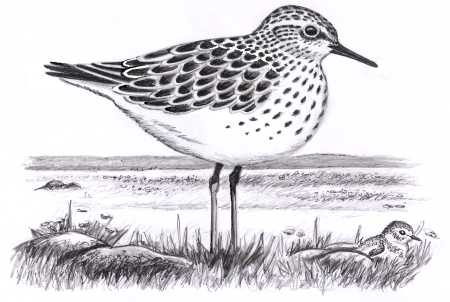
Dear Bird Folks,
While I was watching some sandpipers on a Cape beach in July, I heard someone say that fall migration has started. Isn’t July a bit early to be talking about fall migration? Am I wrong?
Ann, Buffalo, NY
Yeah, You’re Wrong Ann,
Fall migration does start in July, at least it does for sandpipers. Sandpipers have a totally different concept of fall than we do. Here in North America we use the Gregorian Calendar, a calendar invented in 1582 by Pope Gregory XIII. Not meaning to be disrespectful, but birds don’t pay much attention to anything the pope says. Well, all the birds except, or course, the cardinals.
When we think of fall, we think of shorter days and cooler weather. Around here that usually happens in late September or early October. But where shorebirds nest, shorter days and cooler weather happen much earlier than that. Shorebirds nest in the Arctic, the high Arctic. They are way, way up north, even farther north than Santa Claus or any of his friends. In the high Arctic, the summer breeding season only lasts a few weeks, so birds have to mate, lay eggs, hatch the eggs and get out before the winter returns. In order to do this, they have made remarkable adaptations.
Many females won’t even lay eggs until the weather warms up enough to produce food, which is mostly insects. Sometimes the weather is so bad that there is no food, thus no eggs or baby birds at all that year. When the female does lay eggs, the eggs are “pyriform” in shape, i.e., large at one end and pointy at the other, like fat round pieces of pie. By laying pie-shaped eggs, the mother is able to fit the eggs closer together for much needed warmth.
Unlike baby songbirds, which are bald, blind and helpless, newly hatched sandpipers pop out of the egg huge, active and ready to go. They immediately start feeding themselves and require little help from the parents except brooding. Brooding, the process of gathering the young birds under a parent for warmth and protection is important to all birds, but especially Arctic nesters. In that harsh environment a young, unprotected bird could easily freeze and end up with the same fate as Ted Williams.
The process of laying eggs, combined with the nasty weather, is very stressful on the females. So about 10 days after the chicks hatch, the females head south to a more favorable climate. The young birds are then entrusted to the care of the males which, as you can imagine, is a scary thought. The males put up with the screaming kids for about another week and then, when no one is looking, they, too, head south.
The young sandpipers, only a few weeks old, now live all alone in the world’s harshest climate. With their parents gone and no one around to offer them advice, the little birds have to finish raising themselves.
Like so many things in the bird world, this next step of shorebird migration totally amazes me. Somehow, someway, thousands of tiny shorebirds, that didn’t even exist a few months earlier, know how and where to fly without any parents, triptiks, or Rand McNally. How they find their way to the Cape is unbelievable. The only other creature up there to give them guidance is the occasional musk ox. And what do musk ox know about finding Cape Cod, they always summer in the Hamptons.
There are many kinds of sandpipers, Ann, and much of this can vary. But the person that you heard was right, for some birds migration does start in early July. So there is no reason it couldn’t be called “fall migration,” even in July. Just don’t tell Pope Gregory XIII.